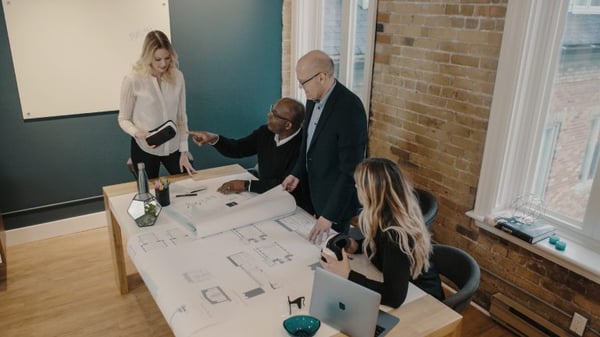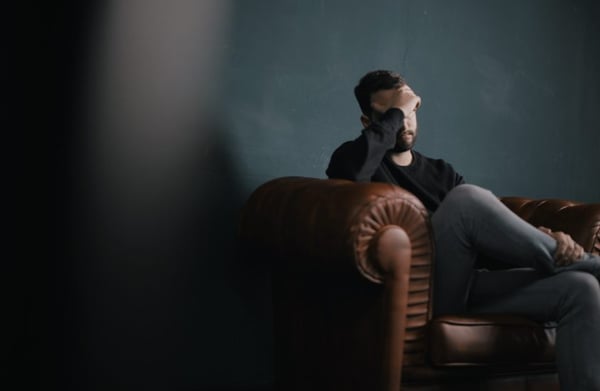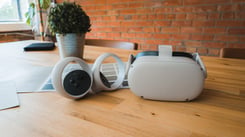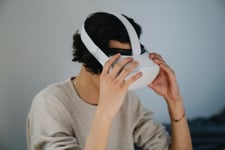When thinking about virtual reality, the first thing that may pop into your head may be related to entertainment. The gaming industry is one of the biggest winning cases for VR, with VR tech companies like Oculus becoming synonymous with other big name consuls like Playstation or Xbox. It’s no surprise that there is significant demand, as VR unlocks the opportunity to take a step further into your screen, and into another world. But that makes the power of VR incredibly versatile and its power exceeds just a single industry.

VR has started to become a revolutionary presentation tool, with B-to-B businesses recognizing its potential and value. Industries like real estate rely solely on a client being able to picture the vision of their potential home. Agents have been able to experience greater flexibility by uploading a VR presentation of a particular property online. This not only saves on time and energy by filtering those who are actually interested in the property, but it also provides an added interactive experience, making your customer service more memorable. Additionally, VR has proved to be really useful for those in architecture and design. As being able to visualize a space is the foundation of the industry, VR fits perfectly into their workflow by allowing A&D individuals to step into their creation.
These two B-to-B industries are just a few examples of VR in Enterprise, however, many businesses that we least expect have started to join the current too.
Mining Industry
One the most unexpected industries that have been turning towards not just VR but also AR has been the mining industry. Arguably, mining is one of the most dangerous occupations known to man, with constant exposure to life-threatening accidents, and lifelong health hazards. Although there have been significant changes to decrease the mortality rate, greater strides in innovation are needed to further improve their working conditions. According to VR Vision, the mining industry has invested about 0.5% of their overall revenue into research and development over the past few years. This has led companies within the mining industry to create thorough training programs on proper safety precautions. Simulated Training Solutions, a South African company, created a VR blast wall for trainees to practice their skills in a safe environment. Instead of making very costly mistakes, areas of improvement are highlighted through markings in the simulation. The virtual simulations provide the extra layer of reality to a situation, yet an effective and low risk means of getting the necessary training. As such, miners will be more equipped to act quickly and safely during high-stress situations.
.jpg?width=600&name=brown-coal-bucket-wheel-excavators-engineering-33192-768x512%20(1).jpg)
Furniture Dealers
As a furniture dealer, it could sometimes be challenging communicating your vision to your clients. On the flip side, from your client’s perspective, it can be hard visualizing that piece of furniture in a particular space. This is when VR steps in. VR has become a useful tool for both furniture dealers and their clients, providing a perfect understanding of what space would exactly look like. As VR can showcase something that doesn’t exist yet, the versatility of the technology can allow you to visit a fictional world, or, on a more practical side, envision what your workplace could look like. Additionally, using VR before investing in fully furnishing an office space is a cost-effective solution. VR allows you to try it before you buy it, discouraging the risk of needing to make costly revisions or redo’s. Moreover, furniture dealers can now provide their clients with the flexibility to review their designs in the convenience of their office, and at their own pace. Conversely, furniture dealers have the opportunity as well to allocate their resources more wisely instead of building multiple models for their clients. Although it may seem like this technology is ways away from where we are now, businesses have found success while using VR to accomplish their goals. If you’re curious about how this technology works with this industry, find out for yourself with this case study.
.jpg?width=600&name=building-chair-comfort-276528-825x550%20(1).jpg)
Therapy
VR therapy is quite an unconventional method that has gained more traction in recent years. One type of therapy that has been utilizing the immersive aspect of VR is exposure therapy. But what kind of method is exposure therapy?

“Exposure therapy targets behaviors that people engage in (most often avoidance) in response to situations or thoughts and memories that are viewed as frightening or anxiety-provoking”
- Matthew Tull, Ph.D. (retrieved from Very Well Mind)
It’s important to address the avoidance, as the behavior can cause greater consequences in the future by interfering with a person’s daily life. Virtual reality exposure therapy (VRET) is starting to be used to treat certain anxiety disorders, such as phobias and Post-Traumatic Stress Disorder (PSTD). VRET immerses an individual to come in simulated contact with their fears to allow them to confront them in a realistic yet controlled and safe environment. So far, VRET has been used to examine Vietnam War combat veterans, resulting in soldiers experiencing reduced PTSD symptoms. Hopefully, in the near future, VRET can be used to help all veterans that have served their country by providing them with much-needed support.
VR has moved far and beyond just being a fad, infiltrating many industries we would not commonly associate with it. It's time to disassociate the technology with just entertainment and take VR in Enterprise seriously. As we are coming to the end of the first month of the new year, how do you envision VR effecting your life?
Here at Yulio, we strive for excellence in performance and integrity when it comes to our product, and customer service. To learn more about how VR can enhance your business workflow, sign up for our FREE 5-day email course. To try our program for yourself, sign up for our free 30-day trial (no strings attached).


.jpg?width=245&height=150&name=active-adult-beautiful-1799244%20(1).jpg)



